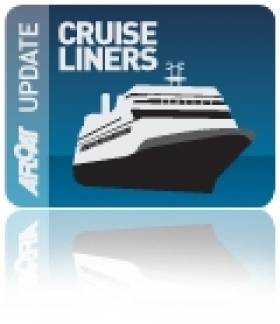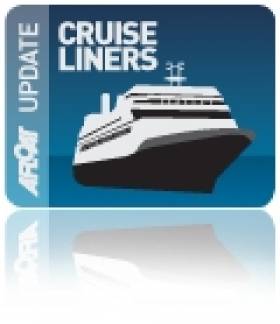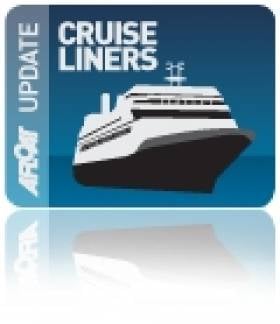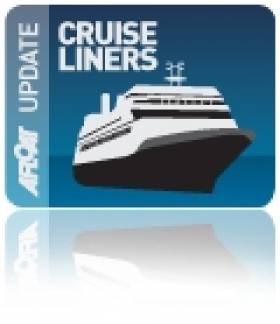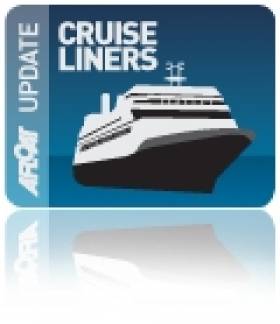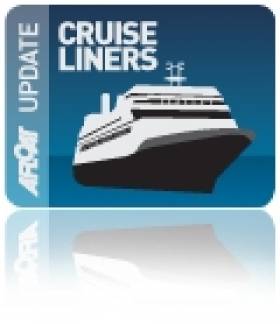Displaying items by tag: Cruise Liners
Cruise & Ferry Winners of ITAA Industry Travel Awards 2015
#TravelWinners – Celebrity Cruise along with Irish Ferries were among the winners at the Irish Travel Agents Association's Industry Travel Awards 2015 held recently in Dublin's Mansion House.
The premier travel awards presented by Miriam O'Callaghan during a Gala Diner included the category of Cruise & Ferry which was sponsored by the Port of Cork Company.
Below are the four sub-category winners:
Best General Cruise Company: Royal Caribbean International
Best Ultra Luxury Cruise Company: Celebrity Cruises
Best Specialist Cruise Company: Uniworld
And the fourth and final award for Best Ferry Company went to Irish Ferries
In the category for Agency Services Provider sponsored by Travelbiz.ie, the following sub-category awards included those from the Cruise Industry.
Best Supplier Support Team: MSC Cruises
Best Supplier Representative: Rebecca Kelly – MSC Cruises
For a complete listing of all categories and links to photo-presentations.
A World of Cruise Holidays Opens in Belfast to be Followed in Dublin
#HolidayShows – The Belfast Telegraph Holiday World Show 2015 which opened yesterday in the Kings Hall Pavillons continues this weekend.
The event covers a myriad of holiday travel options with many stands to visit. Among the exhibitors at the show are Ferry Companies & Cruise Lines. To ask all those important travel questions and to see in advance the list of operators, click HERE.
Following the Belfast show, the annual event returns to Dublin for the Holiday World Show (23-25 January) held in the RDS Simmonscourt Pavillon, Ballsbridge.
Likewise, Ferry Companies & Cruise Lines will be represented, to see the list, click HERE.
In addition, Eoghan Corry's Travel Clinics will run throughout the three-day Dublin show, where experts from the cruise industry will be there to answer consumer questions following presentations.
For information on times, dates and admission prices to the Belfast and Dublin shows, scroll to the bottom of website page.
Cruise Operator Finalists Announced for Irish Travel Industry Awards
#AwardFinalists - Finalists for the Irish Travel Agents Association's Industry Travel Awards 2015 have recently been announced for an award ceremony to be held next week.
The Irish Travel Industry Awards (ITAA), are the premier awards for suppliers and travel agents in Ireland. The awards are designed to showcase excellence in the delivery of international travel services to both leisure and business customers travelling from Ireland.
The Awards will commend a range of companies from air and sea transport companies, through tour operators, destination representatives and specialist service providers to the trade.
The Mansion House, Dublin, will be the venue for the award ceremony on Thursday January 22, when winners will be announced including those in the category from the Ferry & Cruise industry, sponsored by the Port of Cork.
Below are the following operators that have been nominated from three-sub-categories:
Best General Cruise Company
Celebrity Cruises, Fred Olsen Cruises, MSC Cruises, NCL, Royal Caribbean International
Best Ultra Luxury Cruise Company
Azamara Club Cruises, Celebrity Cruises, MSC Cruises – Yacht Club, Royal Caribbean International, Silversea Cruises
Best Specialist Cruise Company (including River)
AMA Waterways, MSC Cruises, Riviera Travel, Royal Caribbean International and also nominated is Uniworld
Best Ferry Company
Brittany Ferries, Irish Ferries, P & O Ferries, Stena Line
To view the list of all the other categories, click HERE.
#DublinPort - Dublin Port's chief executive has moved to dispel criticism of the city's Docklands an entry point for tourists, coming after another bumper year for cruise traffic.
Speaking to Bobby Kerr on NewsTalk's Down to Business show yesterday (10 January), Eamon O'Reilly hailed the port's growth – 7% last year alone, with 5% growth expected in the coming year – and its welcoming of more than 140,000 passengers on board 86 cruise liners in 2014.
But he also brushed aside accusations that the industrial appearance of Dublin Port gives a poor impression to cruise visitors docking in the area.
"We built the business from nothing to 100 ships in 2013, 86 in 2014. If you're building any business, or any stream of business, you don't go out and spend huge amounts of money to build infrastructure," he said.
"You don't do that, you work with what you have, which is what we have done. So it's funny, we seem to get criticised for our own success."
Beyond the port, O'Reilly commented on the untapped potential of the Liffey quays for boat traffic and the industries that might support, though noted the dilemma that "as you try to do more with the Liffey, the bridges start to get in your way."
He also detailed plans for the future that include another bid to bring the Tall Ships back to the capital in 2019, as well as progress on the Alexandra Basin project to increase the port's capacity for bigger container and cruise ships, not to mention increased ferry traffic.
An Apt Belfast Call Given Cruise Operator’s Relation to Harland & Wolff
#FredOslenH&W – Fred. Olsen Cruise Lines Boudicca (1973/28,551grt) docked this morning at Liverpool following an apt port of call to Belfast, given her berth facing opposite Harland & Wolff Industries is a Fred. Olsen related company, writes Jehan Ashmore.
Boudicca had berthed on the north bank of the Lagan directly across from H&W's Queens Island facility from where ships are dry-docked, repaired, converted in addition to where marine engineering projects are carried out on site.
Also facing opposite Boudicca, the historic pump-house that was used for the dock in which the RMS Titanic was built as previously reported, is to be transformed into a visitor centre for HMS Caroline.
Having completed her call to Belfast yesterday, Boudicca made her final-leg of the cruise when arriving in the early hours at Liverpool Cruise Terminal.
This cruise was the third out of four Irish Sea festive mini-taster cruises ranging from 1, 2 and 3 nights.
All the cruises start from Merseyside for UK guests booked with the 4-star cruise ship operator. During calls to Dublin Port, Irish clients embark from Ocean Pier within Alexandra Basin.
Since Afloat.ie's last report about Boudicca, the German built cruise ship had also made an interim cruise from Merseyside with calls to Dublin, Cork (Cobh) and Belfast.
On her final festive Irish Sea cruise, Boudicca is to depart Liverpool tomorrow night and arrive in Dublin on Saturday.
Festive Fred. Olsen Mini-Taster Irish Cruise Underway
#FestiveMiniCruises – Boudicca (1973/28,551grt) of Fred. Olsen Cruise Lines has this evening departed Dublin Port on a 2 night mini-cruise for Irish passengers bound for Liverpool, writes Jehan Ashmore.
The cruise which departed Ocean Pier is one of several festive 'taster' Irish Sea cruises before Christmas.
Fred Olsen, the four-star operator is offering a choice of 1, 2 and 3 night cruises to attract the Irish market as well as the UK.
Last night, Boudicca departed Liverpool's Cruise Terminal to Dublin to where passengers experienced the Irish capital before embarking this evening with Irish passengers to Merseyside.
The other cruises will have an intinerary to include Belfast, Cork (Cobh) and Liverpool plus en route calls to Dublin to collect Irish guests.
Largest Cruiseships to Killybegs to Visit in 2015
#Cruiseliners - Killybegs Information Centre has confirmation through Sinbad Marine Services that three visits to the port in 2015 have been scheduled by the prestigious brand P&O/Carnival Lines.
The cruiseships to visit Killybegs under the P&O Cruises flag will be the largest passenger ships so far to use the port. Among the brands of Carnival Group are famous lines such as Cunard, Princess Cruises and Holland America Line.
P&O's Adonia is due in port on June 17 and will return for a second visit on July 21. A second P&O Cruises fleet-member Oriana, which is twice the size, is due to berth on June 26.
The calls by P&O brings to a total of eight callers confirmed for 2015, and passenger figures visiting Killybegs next year is greater than last year's season, itself a record.
The 30,000 tonnes Adonia, with a length of 180.45 m (592 ft) is smaller by comparison to the 69,000 tonnes Oriana with a length of 260.00 m (853.02 ft).
Adonia has a capacity for more than 800 passengers while Oriana has a maximum capacity of more than 1,900 passengers with a crew of just under 800 (794).
Anne Dorrian of the Killybegs Information Centre said "This is great news and we hope it will lead to even bigger vessels visiting Killybegs in the future".
"The Adonia is a pathfinder ship, exploring ports which the larger ships of today had not previously considered. Hopefully, her visit will pave the way for some of the most splendid ships in the Carnival fleet to come to beautiful County Donegal."
She added "Between 2009 and 2014, there have been 52 visits by cruise ships to Killybegs with over 22,000 passengers and more than 6,000 crew. In 2015, the eight ships confirmed will bring an estimated 6,300 passengers to the town.
Carnival Cruise Lines is a British-American owned company, based in Florida and the brand is one of ten forming Carnival Corporation & plc.
The line has the largest fleet in the group, with 24 vessels accounting for more than 21% of the worldwide market share.
High-End Market Cruise Callers to Visit Shannon Season 2015
#CruiseCallers – A pair of cruiseships from the high-end of the luxury market, are to visit the Shannon Estuary with calls to Foynes Port in the 2015 season, writes Jehan Ashmore.
According to Shannon Foynes Port Company, the cruise calls will both take place in May with Compagnie du Ponant's mega-yacht styled cruiseship Le Boréal followed within the same week by the six-star Silver Whisper.
Le Boréal only takes a maximum of 264 passengers pampered in luxurious and intimate surroundings from the hand of French designer Jean-Philippe Nuel. The 142m vessel built by Italian shipbuilding group Fincantieri has up to 132 cabins and all are outside.
The leadship of a quartet was rewarded 'Best New ship of the Year 2010' by the European Cruiser Association.
Silver Whisper, a Millenium class vessel of the SilverSeas Cruises accommodates for 382 guests. The operators of 28,258 tonnes cruiseship, offers a highly individualized service.
The floating resort includes shopping experiences to that of a boutique hotel. In The Telegraph - Ultratravel 100 Awards, the company were awarded 'Best Small Luxury Cruise Line' 2014.
Lusitania Memorial Cruise To Visit Cobh Next May
#Lusitania - A special memorial cruise celebrating the Lusitania on the centenary of its sinking will visit Cobh next summer, as the Irish Examiner reports.
May 7 is the date to mark in your calendars to see the Cunard cruise liner Queen Victoria dock at expanded facilities in the Cork Harbour town amid a host of events to mark the anniversary.
The 'Lusitania Remembered' cruise, which sets out from Southampton on 3 May next, will also host an exhibition of memorabilia from the ill-fated liner, torpedoed by a German U-boat in 1915.
The Irish Examiner has more on the story HERE.
Magellan, the Newcomer to Join Cruise & Maritime Voyages Fleet in 2015
#NewCMVflagship – UK operator, Cruise & Maritime Voyages (CMV) are to introduce Magellan in Spring 2015 as their new flagship and like the Marco Polo, Astor and Azores, she will operate as an adult-only friendly ship, writes Jehan Ashmore.
At 46,052grt Magellan is the largest member of the CMV fleet which in association with sister company TransOcean Kreuzfahrten operate a trio of river-based cruise vessels in Europe.
Magellan is to replace Discovery, which as previously on Afloat.ie, opened the Belfast Harbour cruise season this year and she is no stranger to other ports on this island. Launched in 1971 as Island Venture, she would later feature with her sister in the US TV series the 'Love Boat'.
As for the Magellan her most recent career was with Costa Crociere serving as their Grand Holiday. In 2010 there was a rebuild and capacity is for approximately 1,250 adult passengers (16 years plus). Accommodated is provided in 726 cabins (incl. 14 Balcony Suites) spanning nine passenger decks and are serviced by eight lifts.
She features wide corridors and stairways and expansive deck areas with wood type decking in many areas. In addition a wide choice of well-appointed lounges and panoramic seating coupled with observation area suited to the operator's scenic cruise programme.
CMV claim that Magellan offers a feeling of intimacy and personal attention when compared with the 'mega' resort style ships built today. They also say that there fleet have no climbing walls or ice-skating rinks and no kids!




























